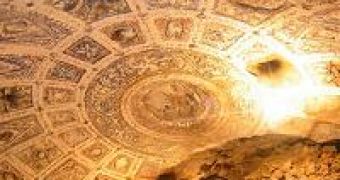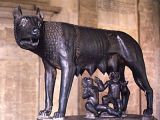This is one of the best known legends of the antiquity, that of the Rome's foundation. The story starts with Romulus' and Remus' grandfather, Numitor, and his brother, Amulius, both inheriting from their father the throne of Alba Longa. But Amulius eliminated his brother and banned Numitor's daughter, Rhea Silvia, from having children (which eventually would have had rights to the throne).
Rhea turned into a Vestal Virgin, a priestess sworn to abstinence, but she remained pregnant nevertheless, having two twins. Rhea was killed and it was ordered that the two boys, Romulus and Remus, should be killed by Amulius. But, the servant named for the job (killing the twins) could not accomplish this, because of their beauty and innocence, and left them in a basket on the banks of the Tiber river. The legend says that the twins were nursed by a she-wolf ("Lupa" in Latin), but this name was also employed for female prostitutes and for priestesses of a fox goddess (so that the she-wolf could have been a woman; even today "zorra" (she-fox) in Spanish means whore, bitch).
Later, the boys were discovered by a shepherd and raised by his family. But, the she-wolf legend is now entangled with the legend of the two founders of Rome. The bronze statue of the she-wolf suckling the twins is encountered at the entrance to the City Hall at Rome's Campidoglio and turned into an enduring symbol of Rome and Latin (Romance) world, copies of it being encountered also in Latin-derived speaking countries, like Spain or Romania.
Now, Italian archaeologists say they have found the cave where the she-wolf suckled Romulus and Remus, in the heart of the Italian capital, announced the Italian Culture Minister, Francesco Rutelli. "Italy and Rome never stop amazing the world with continuous archaeological and cultural discoveries, and it is incredible to think that we have finally found a mythological site that has become a real site," said Rutelli.
"The domed underground cavity, ellaborately decorated with seashells and mozaics, was discovered near the ruins of Emperor Augustus's palace on Rome's Palatine Hill using a camera-equipped laser probe," Maria Bonmassar of the Italian culture ministry told AFP. The cave was named "The Lupercale" by ancient Romans ("lupus" means "wolf" in Latin, see French "loup", Spanish "lobo", Roumanian "lup"), where a yearly pagan celebration in the honor of the shepherds' god Faunus Lupercus (the counterpart of the Greek Pan) took place.
"The grotto, which is some 6.5 m (21 ft) high and 7 m (24 ft) in diameter is on a site dating from the Bronze Age. Digging in the grotto will begin next year", Bonmassar said.

 14 DAY TRIAL //
14 DAY TRIAL // 
